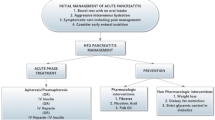Abstract
Whether hyperlipidemia is a pre-existing metabolic disorder or a consequence of acute pancreatitis is still debated. Mild to moderate elevation of serum triglyceride levels are likely to be an epiphenomenon of the pancreatic disease. A marked hyperchylomicronemia and hypertrygliceridemia would be needed to trigger acute pancreatitis; a relevant defect in the lipid catabolism and clearance should therefore pre-exist. The aim of the present study was to investigate whether patients with acute pancreatitis and marked hyperlipidemia have an impaired clearance capacity of exogenous lipids, which would define the hyperlipidemia as a preexistent abnormality and therefore a potential cause of the pancreatic disease. With this aim, the kinetics of the removal of exogenous triglycerides from the circulation have been analyzed. Twenty patients with acute pancreatitis have been studied. Ten of them suffered from an episode of acute pancreatitis with marked hyperlipidemia (serum triglyceride levels>20mmol/L). Four to six months after recovery from the pancreatitis, a two-stage infusion of Intralipid 20% was carried out and the fractional removal rate (K2) and the maximal clearance capacity (K1) of exogenous triglycerides were calculated. At low infusion rates a first order kinetics for removal was observed, whereas at high infusion rates a zero order kinetics was operating. All patients with a previous attack of normolipidemic acute pancreatitis had normal K2 and K1 values. Five patients with previous hyperlipidemic acute pancreatitis had an abnormally low clearance capacity of exogenous triglycerides, whereas the remaining five had normal removal values. The present study provides new information in the association between hyperlipidemia and acute pancreatitis by showing that even a marked elevation of serum lipid levels should not be invariably considered as the etiological factor of the pancreatic disease, even if other potential causes are not evident.
Similar content being viewed by others
References
Domínguez-Muñoz JE, Malfertheiner P, Ditschuneit HH, et al. Hyperlipidaemia in acute pancreatitis. Relationship with etiology, onset, and severity of the disease.Int J Pancreatol 1991; 10: 261–267.
Cameron JL, Capuzzi DM, Zuidema DG, Margolis S. Acute pancreatitis with hyperlipidaemia: The incidence of lipid abnormalities in acute pancreatitis.Ann Surg 1973; 177: 483–489.
Dickson AP, O’Neill J, Imrie CW. Hyperlipidaemia, alcohol abuse and acute pancreatitis.Br J Surg 1984; 71: 685–688.
Greenberger NJ. Pancreatitis and hyperlipidaemia.N Engl J Med 1973; 289: 586, 587.
Ditschuneit H. Hyperlipoproteinemia in the pathogenesis of acute pancreatitis, inAcute Pancreatitis, Beger HG, Büchler M, eds. Springer, Berlin-Heidelberg 1987; pp. 32–40.
Buch A, Buch J, Carlsen A, Schmidt A. Hyperlipidaemia and pancreatitis.World J Surg 1980; 4: 307–314.
Farmer RG, Winkleman EI, Brown HB, et al. Hyperlipoproteinemia and pancreatitis.Am J Med 1973; 54: 161.
Lewis B. Hyperlipidaemia, inthe Metabolic and Molecular Basis of Acquired Disease, Cohen RD, Lewis B, Alberti KGMM, Denman AM, eds. Baillière-Tindal: London 1990; pp. 860–920.
Toskes PP. Hyperlipidemic pancreatitis.Gastroenterol Clin North Am 1990; 19: 783–791.
Durrington PN, Cairns SA. Acute pancreatitis: a complication of beta-blockade.Br Med J 1982; 284: 1016.
Cameron JL, Capuzzi DM, Zuidema GD, Margolis S. Acute pancreatitis with hyperlipaemia. Evidence for a persistent defect in lipid metabolism.Am J Med 1974; 56: 482–487.
Guzman S, Nervi F, Llanos O, Leon P, Valdivieso V. Impaired lipid clearance in patients with previous acute pancreatitis.Gut 1985; 26: 888–891.
Rollán A, Guzmán S, Pimentel F, Nervi F. Catabolism of chylomicron remnants in patients with previous acute pancreatitis.Gastroenterology 1990; 98: 1649–1654.
Durrington PN, Twentyman OP, Braganza JM, Miller JP. Hypertriglyceridaemia and abnormalities of triglycerides catabolism persisting after acute pancreatitis.Int J Pancreatol 1986; 1: 195–203.
Ehrlich EW, Spitzer JJ, Howard JM. Pancreatitis with hyperlipaemia.Surg Forum 1960; 11: 373.
Wang C, Adlersberg D, Feldman EB. Serum lipids in acute pancreatitis.Gastroenterology 1959; 36: 832.
Stackhouse KC, Glass DD, Zimmerman B. Relationships of lipoprotein lipase and hyperlipidaemia in pancreatitis.Surg Forum 1966; 17: 343.
Wang C, Strauss L, Adlersberg D. Experimental pancreatitis and plasma lipids.Gastroenterology 1958; 35: 465.
Haber PS, Wilson JS, Apte MV, Hall W, Goumas K, Pirola RC. Lipid intolerance does not account for susceptibility to alcoholic and gallstone pancreatitis.Gastroenterology 1994; 106: 742–748.
Glueck CJ, Scheel D, Fishback J, Steiner P. Oestrogen-induced pancreatitis in patients with previously covert familial type V hyperlipoproteinaemia.Metabolism 1972; 21: 657–665.
Chait A, Mancini M, February AW, Lewis B. Clinical and metabolic study of alcoholic hyperlipidaemia.Lancet 1972; 2: 62–64.
Rössner S. Studies on an intravenous fat tolerance test. Methodological, experimental and clinical experiences with Intralipid®.Acta Med Scand 1974; 196(suppl. 564): 1–24.
Kessler JI, Kniffen JC, Janowitz HD. Lipoprotein lipase inhibition in the hyperlipidaemia of acute pancreatitis.N Engl J Med 1963; 269: 943–948.
Kessler JI, Miller M, Barza D, Mishkin S. Hyperlipidaemia in acute pancreatitis.Am J Med 1967; 42: 968–976.
Lewis B, Boberg J, Mancini M, et al. Determination of the intravenous fat tolerance test with Intralipid by nephelometry.Atheroschlerosis 1972; 15: 83–86.
Dagher FJ, Lyons JH, Finlayson DC, Shamsai J, Moore FD, et al. Blood volume measurement: a critical study. Prediction of normal values.Adv Surg 1965; 1: 69–74.
Author information
Authors and Affiliations
Rights and permissions
About this article
Cite this article
Domínguez-Muñoz, J.E., Jünemann, F. & Malfertheiner, P. Hyperlipidemia in acute pancreatitis. Int J Pancreatol 18, 101–106 (1995). https://doi.org/10.1007/BF02785883
Received:
Accepted:
Issue Date:
DOI: https://doi.org/10.1007/BF02785883




